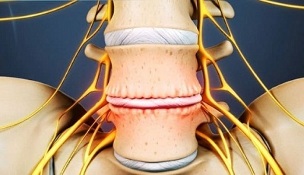Timely treatment of an illness can increase the chances of a speedy and successful recovery. But in any case, it is better not to allow the development of a disease, especially of such a serious disease as osteochondrosis of the cervix.
Definition of cervical osteochondrosis

Cervical osteochondrosis is a fairly common disease that has recently increasingly affected young people. The disease affects the intervertebral discs in the cervical spine. Often, the development of the pathological process of degenerative-dystrophic changes is facilitated by an incorrect body position, for example, due to long work at the computer.
Among other things, the problem can be caused due to genetic predisposition, poor behavior, uncomfortable sleeping place and a sedentary lifestyle. Despite the fact that this type of osteochondrosis develops quite slowly, it tends to progress.
In elderly patients, this disease is mainly combined with other degenerative processes, for example:
- intercostal osteoarthritis;
- spondylosis;
- invertebrate arthrosis etc.
Symptoms
As for the most characteristic symptoms, first of all, the appearance of acute pain arising from the tightening of the nerve endings can be noticed. The pain often focuses on the lumbar, cervical and back regions. Additionally, you can find other syndromes:
- cardiac syndrome- consists of several symptoms that are similar in appearance to angina pectoris. This syndrome develops during irritation of the roots of the pectoralis major muscle or phrenic nerve. Because of this, a person experiences painful sensations of an oppressive nature in the area of the heart muscle, which can arise periodically and last for several hours. Sneezing or sudden movements of the head often aggravate the pain. Moreover, during painful attacks, no changes in the cardiogram can be detected;
- radicular syndrome- occurs when the nerve endings in the spine of the cervix are tightened. At this point the pain is felt, which can radiate not only to the forearm, shoulder or shoulder blade, but also to the lumbar region. The patient may feel tingling or more pronounced sensations, depending on the onset of osteochondrosis;
- irritant-reflex syndrome- manifested by a burning sensation in the neck and neck. Such symptoms often appear after waking up from sleep, during sharp turns of the head, coughing and sneezing. Moreover, the pain may appear not only in the shoulder area but also in the chest area; Vertebral Artery Syndrome Often with this syndrome, it is the constant pain that occurs, but sometimes it can arise and subside.
Pay attention!In the presence of symptoms of cervical osteochondrosis, experts note in a person increased fatigue, which can cause hearing and vision impairment.

As for the other main symptoms of the disease, these include:
- Compression of blood vessels, which causes an increase in blood pressure;
- Severe headaches that occur due to impaired blood circulation to the brain. This type of pain can cause the patient to use pain relievers regularly;
- vision and hearing problems;
- pain, quite strong in the neck and shoulders, which can sometimes be aggravated by the sharp and very unpleasant "lumbago";
- grinding and crushing when tilting the head or turning sideways;
- decrease in muscle strength in the arms due to pain in the chest area;
- dizziness.
Important!As soon as the first symptoms of this disease are noticed, it is necessary to seek help from a neurologist as soon as possible.
Reasons
The main causes of osteochondrosis are:
- Metabolic disorders that adversely affect the normal state of cartilage in the intervertebral discs.
- Insufficient mobility of the cervical vertebrae, due to which there is a loss of fluid, which, in turn, negatively affects the elasticity of the cartilage.
- Microtrauma of the cervical spine, during head tilts, curves, etc.
- Poor legacy, due to which the disk security limit is very small.
Treatment
The therapy process depends directly on the stage of the disease and is based on an integrated approach. On average, treatment lasts from 1 to 3 months, after which it is necessary to support the elimination of symptoms with preventive measures for about 1 year more.
The main treatment is performed in 2 directions, depending on the patient's health condition and the level of neglect of the disease. As for conservative treatment, this includes taking medication and exercising. Treatment using surgery is performed only if the conservative did not give any effect.
it is very importantto follow a diet and be sure to follow the recommendations regarding therapeutic exercises.
Conservative treatment aims to relieve pain, restore and normalize spinal function, and prevent lateral changes. In such therapy, a whole range of therapeutic measures is used:

- spinal traction (traction). With the use of special medical equipment, the spine is stretched in order to increase the distance between the vertebrae;
- drug therapy. The use of drugs during this disease is mainly aimed at relieving pain, relieving inflammation and general normalization of metabolic processes in the body;
- physiotherapy. Thanks to such procedures, it is possible not only to reduce pain, but also to improve the effect of taking medication. Such methods are also used during the rehabilitation period. In this case, laser beams, ultrasonic waves, low frequency currents, work with magnetic fields, etc. are often used.
- kinesitherapyand exercise-based exercise therapy;
- manual therapy. Such treatment is chosen individually for each patient;
- massage. Thanks to massage, you can speed up blood circulation to the tissues, remove muscle cramps and spasms, in general, improve the blood supply to the tissues of the whole body.
Despite the fact that medicines alone can not cure osteochondrosis, they can help restore the blood supply to the tissues. Therapy should be comprehensive, only in this case we can talk about the effectiveness of treatment. In addition to taking medication, it is imperative to engage in physiotherapy exercises, follow a diet, and give up bad habits.
In the absence of pain or marked dystrophic changes, taking over-the-counter medication is inappropriate. The following types of medications are used to treat this disease and relieve pain:
- means for regeneration, as well as for the prevention of cartilage tissue degeneration: hyaluronic acid and analogues;
- to relieve inflammation;
- preparations for improving tissue blood supply: B vitamins;
- antispasmodics; antioxidants
- : vitamins N, E and C.

Medications can be prescribed not only as tablets and capsules for oral administration, but also as injections or day ointments / creams. If there are acute complications, medications are used to block the nerve endings.
Along with drug therapy, it is very important to maintain a healthy lifestyle and proper nutrition. Drink at least 1. 5 liters of water a day.
One and a half liters of water a day is the recommended rate for the health of the joints and the whole body.
Of course, you can also use herbal teas, fruit drinks, dried fruit compotes or mineral water. Coffee, strong black tea, alcohol and carbonated beverages should be eliminated from the daily diet.
Prevention
The main causes of osteochondrosis are ignoring the demands of the body, heavy loads and improper diet. This is why prevention should be based on the complete elimination of adverse effects on the spine and the prevention of the onset of pathological changes. For these purposes, it is enough to adhere to the usual rules of a healthy lifestyle:
- only moderate physical activity during sports: morning exercises, gymnastics, athletics, if the types of wrestling, then contact, swimming is an excellent option;
- in the case of a long stay in one position, for example, when working sitting, it is very important to take a break, at least once in 45-60 minutes. During this period, you should give your body 5-15 minutes for a little warmth, which will restore normal blood circulation. It is also very important to pay attention to the correct choice of office chairs or armchairs, giving priority to those who will support the spine, control the correct position of the hands on the table and feet on the floor. Try to independently monitor your posture (your shoulders should be in a relaxed position and your back should be straight);
- It is important to try to control your emotionality in case a spasmodic reaction occurs during stress. For these purposes, you need to learn relaxation techniques and participate systematically in massage for the overall strengthening of the body;
- To sleep, it is best to choose an orthopedic mattress with a flat surface. Of course, it will not be as soft as a feather bed, but its elasticity will ensure proper body position;
- Drinking plenty of fluids and eating right helps not only to maintain metabolism but also to strengthen the overall body:

Mental state also has a negative effect on the condition of the joints.
- in case you need to move or lift heavy things, it is very important to do it as normally as possible, without sudden jumps and jerks from the half squat position. It will not be superfluous to use a special support strap;
- An important point is to choose high quality orthopedic shoes without high heels, with sufficient foot width. It is also possible to reduce the load on the back by replacing worn shoes in time, which is especially important for women. In summer, in the dacha, at sea, if possible, you should walk barefoot on different surfaces, thus strengthening the leg muscles.
important it is important to rememberthat prevention is much better and easier than subsequent treatment of the disease.
Exercises
Under no circumstances should you start physical activity and exercise without a doctor's prescription or before the pain syndrome is relieved. The specialist must first alleviate any acute symptoms. In the presence of pain symptoms, gymnastics will be painful.
There are some really effective and simple exercises. They can be performed not only at home but also anywhere, including work or even on the street.
Start performing exercises, in all cases the initial posture is sitting in a chair, hands folded at the knees:
It is worth starting with a warm-up:
- In the starting position, you should slowly turn your head to one side until it stops, and then to the other. At this point, you should feel how the neck muscles stretch. Once the neck is turned to one side until it stops, you should turn it a few degrees as carefully as possible, avoiding sudden movements and adjusting it to this position for 5 seconds. Experts recommend starting each exercise with a warm-up to strengthen the neck muscles. In each direction, it is enough to perform 5 turns to develop the strength and flexibility of the neck.
- Next, you need to tilt your head so that the ear is close to your shoulder. It is worth noting that at this point, the shoulder should remain immobile. At maximum approximation, you need to adjust the position. Be careful to ensure that the actions do not cause discomfort or pain. It is enough to perform such tendencies 5 times for each pair.

Next, skip to the main exercises:
- Now that the warm-up is over, you can move on to specific exercises that can give a good result. In the starting position, you should rest your hand on the right temple. Now you should try to tilt your head to the right, and the hand at this point should prevent this. The effort must have been such that it was heavy, but the head still tilted gradually in this direction. For each side, 10 slopes will suffice. Of course, the hand also needs to be changed.
- Next, you need to grab the occipital region of the head, and while creating resistance, try tilting the head back 5 times.
- Exactly the same exercise should be done in the case of supporting the palms on the forehead. Through resistance, you have to pull the chin to the chest. Will be enough for 5 turns forward.
- The end of the exercise can be the warm-up of the traps, which is performed by lowering and raising the shoulders. At the highest point, you should close for a few seconds, then lower yourself and relax completely. Enough for 10 repetitions.
- Complete the exercise by stretching your neck in different directions. This set of exercises should be performed daily. This is an excellent opportunity to warm the neck with osteochondrosis.
In addition to strength training, neck flexibility exercises may be included. They will help not only strengthen the neck muscles, but also the tendons. The heat will make your neck more mobile.
Exercises are recommended by experts not only for osteochondrosis of the cervical spine, but also for all people over 30 years old. The problem is that at this age, muscle fibers lose their flexibility, so it is important to maintain them, along with the overall health of the body.
- the chin should be pulled to the chest and at this point help the head with the hands.
- Very carefully, with your hands you should tilt your head sideways to touch the shoulder with your ear.
Only the correct treatment at the first symptoms of osteochondrosis will allow you to quickly cope with this problem and return to normal life, without pain and discomfort.
Next, you need to make some circular movements of the head in one direction and then in the other. It will be enough for 8 turns for each side. Exercise should be done very carefully. For safety reasons, you can hold your head with your hands.

















































